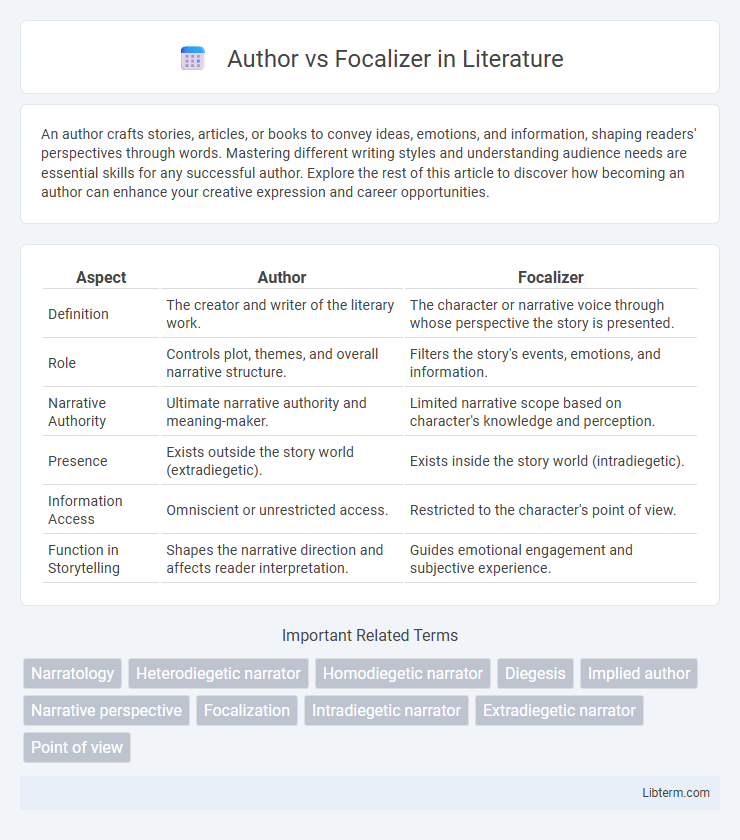An author crafts stories, articles, or books to convey ideas, emotions, and information, shaping readers' perspectives through words. Mastering different writing styles and understanding audience needs are essential skills for any successful author. Explore the rest of this article to discover how becoming an author can enhance your creative expression and career opportunities.
Table of Comparison
| Aspect | Author | Focalizer |
|---|---|---|
| Definition | The creator and writer of the literary work. | The character or narrative voice through whose perspective the story is presented. |
| Role | Controls plot, themes, and overall narrative structure. | Filters the story's events, emotions, and information. |
| Narrative Authority | Ultimate narrative authority and meaning-maker. | Limited narrative scope based on character's knowledge and perception. |
| Presence | Exists outside the story world (extradiegetic). | Exists inside the story world (intradiegetic). |
| Information Access | Omniscient or unrestricted access. | Restricted to the character's point of view. |
| Function in Storytelling | Shapes the narrative direction and affects reader interpretation. | Guides emotional engagement and subjective experience. |
Defining the Author: Who Creates the Text?
The author serves as the originator of a text, responsible for its creation and underlying intentions, shaping narrative structure and content. In literary theory, the author's voice contrasts with the focalizer, who represents the perspective through which the story is filtered within the narrative. Understanding the distinction between author and focalizer clarifies the difference between external creation and internal narrative perspective, essential for textual analysis.
Understanding the Focalizer: The Lens of the Narrative
The focalizer serves as the narrative lens through which events and characters are perceived, directly shaping the reader's experience and interpretation. Unlike the author, who exists outside the story, the focalizer operates within the narrative world, providing a subjective perspective that colors the plot and emotional tone. Understanding the focalizer reveals how narrative bias, internal thoughts, and selective knowledge influence storytelling and deepen thematic complexity.
Authorial Intent vs. Narrative Perspective
Authorial intent refers to the creator's purpose and meaning behind a text, shaping its themes and messages, while narrative perspective, or focalization, defines the viewpoint through which the story is experienced by readers. Understanding the distinction between the author as the originator of content and the focalizer as the narrative lens enhances analysis of how meaning is conveyed independently of authorial motivation. This differentiation allows for a deeper exploration of storytelling techniques, emphasizing how characters' perceptions and biases influence the narrative structure and reader interpretation.
Internal vs. External Focalization
Internal focalization centers the narrative perspective within a character's consciousness, revealing thoughts, feelings, and sensory experiences, whereas external focalization confines the viewpoint to observable actions and dialogue without direct access to internal states. Authors utilize internal focalization to deepen psychological insight and engender empathy, while external focalization maintains narrative objectivity and invites readers to interpret characters' motivations independently. Understanding the distinction between internal and external focalization enhances literary analysis of narrative techniques and the dynamics between authorial control and character subjectivity.
The Role of the Author Outside the Story
The author operates outside the story as the creator and controller of narrative elements, shaping plot, characters, and themes, while the focalizer serves as the narrative lens through which the story is perceived and experienced. The author's role encompasses establishing context, tone, and perspective beyond the immediate narrative, providing a framework that influences interpretation without being confined to the characters' viewpoints. Understanding the distinction between author and focalizer illuminates how narrative authority and subjective experience coexist, enhancing analysis of storytelling techniques and reader engagement.
Focalizer’s Influence on Reader Perception
The focalizer shapes reader perception by controlling the narrative viewpoint, filtering events through a specific character's thoughts and emotions, which creates a subjective experience aligned with their perspective. This narrative technique enhances emotional engagement and allows readers to empathize deeply with the focalizer's understanding and biases. By limiting information to what the focalizer accesses, authors manipulate suspense and interpretation, profoundly influencing the reader's connection to the story.
Shifting Focalizers: Multiplicity in Perspectives
Shifting focalizers enable narratives to present multiplicity in perspectives by altering the viewpoint through which events and characters are perceived, enriching the reader's understanding and emotional engagement. This technique allows authors to explore complex themes and character motivations from diverse angles, creating a layered and dynamic storytelling experience. The distinction between author and focalizer becomes crucial, as the author controls the narrative framework while focalizers offer subjective interpretations within the story world.
Case Studies: Author and Focalizer in Literature
The distinction between Author and Focalizer is crucial for narrative analysis, with the Author representing the real-world creator of the text and the Focalizer serving as the character through whose perspective the story unfolds. Case studies in literature demonstrate how focalization shapes readers' interpretation by filtering events and emotions through specific characters, altering narrative reliability and engagement. Examining works like Henry James' "The Turn of the Screw" reveals the complex interplay between Authorial intent and Focalizer bias, enriching the thematic depth and ambiguity of the text.
Impact on Theme and Narrative Structure
The distinction between author and focalizer significantly impacts theme development and narrative structure by shaping the perspective from which the story is told. The author's overarching intentions guide the thematic framework, while the focalizer's subjective viewpoint influences how themes are experienced and interpreted through specific character consciousness. This dynamic interplay results in a layered narrative structure where thematic depth emerges from the contrast between external authorial control and internal focalization.
Author vs. Focalizer: Why the Distinction Matters
The distinction between author and focalizer is crucial in narrative theory, as the author represents the external creator of a text, while the focalizer is the character whose perspective shapes the narrative. Understanding this difference clarifies how subjective viewpoints influence a story's interpretation and emotional impact. Focusing on the focalizer allows readers to identify biases and reconstruct unreliable narratives, enhancing critical engagement with the text.
Author Infographic

 libterm.com
libterm.com